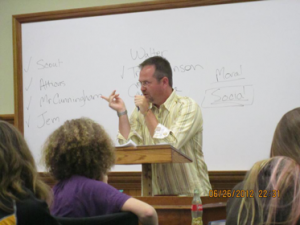
Field Reports in Biblical Studies: A Teaching without Teaching Experiment
We all know that our students’ social and religious contexts shape the way they understand the Bible – in theory, at least. But how do we bring that knowledge into the classroom? This question is particularly acute in a diverse theological seminary. With just over one hundred students, Lancaster Theological Seminary classrooms represent over twenty denominations, all postgraduate age cohorts, an astonishing array of life experiences, and a significant and growing racial diversity.
In my experience one great challenge involves helping students articulate the assumptions they carry concerning how we find meaning in the Bible. A seminary classroom, dedicated to preparing students as public interpreters of Scripture, assumes the Bible’s meaning is open to question. Many Christian traditions do not share that assumption, and I have struggled to assist students in developing self-awareness concerning their own contexts. Moreover, I have wondered how students might teach one another to appreciate the hermeneutical diversity that marks our classrooms.
To these ends I have developed a new assignment for this semester: a field report for an introductory course in New Testament. This first graded  assignment of the semester requires students to listen to a sermon in a worship service of their own tradition. Simply, they note the Bible passages read and referred to, briefly explain how the preacher treats those passages, and then – this is the hard part – explain the logic by which the preacher constructs meaning from those texts.
assignment of the semester requires students to listen to a sermon in a worship service of their own tradition. Simply, they note the Bible passages read and referred to, briefly explain how the preacher treats those passages, and then – this is the hard part – explain the logic by which the preacher constructs meaning from those texts.
A few days ago we devoted a class period to the process by which students share their field reports. I had assumed that we would hear everything from the use of Scripture as a pretext, sermons that veer from a passage into broader topics, sermons that extrapolate multiple thematic points from the text, sermons that jump around through a series of passages, and sermons that draw out correspondences between the Bible and the congregation’s lived experience. Perhaps we could fit the students’ reports into such neat categories, but that seems beside the point now that we’ve discussed them.
My unscientific sample reflects that the learning occurs not in the assignment itself but in the follow-up. Students easily summarize the sermons they hear, but they struggle to articulate the logic that joins Scripture to proclamation. One white mainline student reports that a pastor seemed to use the lectionary reading as a pretext for justifying her opinion about the crisis in Syria. In my written comments I asked the student if perhaps the preacher had already determined what she believed about Syria, but the biblical text helped her think through that position with more insight. That follow-up conversation opened another way of hearing the sermon, according to the student. More to the point, students evaluated the class session most positively, as (with some help) they showed one another the wide variety of hermeneutics we all bring to class. This we already knew: students often teach one another more effectively than faculty do.